
Cite this as: Fernandes, A.B. 2018 "But will there be visitors?" Public outreach efforts using social media and online presence at the Côa Valley Museum and Archaeological Park (Portugal), Internet Archaeology 47. https://doi.org/10.11141/ia.47.5
Since its discovery in 1994, the Côa Valley rock art complex has been the focus of a protection, conservation and research project, promoting and creating a tourism and educational programme based on its unique rock art heritage as inscribed by UNESCO on the World Heritage List (Fernandes 2004, 2007; Baptista and Fernandes 2007). The project contributes to foster sustainable development dynamics in a disadvantaged interior area of Portugal. The Côa Valley Archaeological Park (Figure 1), open to the public since 1996 and the Côa Museum (Figure 2), open since 2010 (Fernandes 2010a), have become major tourist attractions. Together, they attract tens of thousands of visitors to the region each year (Real 2014).

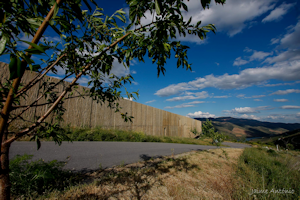
It could be said that the true museum is the last 17 kilometres of the Côa River where over 80 rock art sites are located, comprising a total of more than 1,000 engraved and, in a lesser quantity, painted outcrops (see Figures 3 and 4; Reis 2014). The chronology of the Côa rock art imagery ranges from the Upper Palaeolithic (the oldest dating to circa 25,000 BP) through to the 1950s; other important artistic periods include the Neolithic and the Iron Age (Baptista and Fernandes 2007). If the Park is the real museum then the Côa Museum should be regarded as the gateway to the valley, acting as a reception and interpretation centre for visitors to the region.
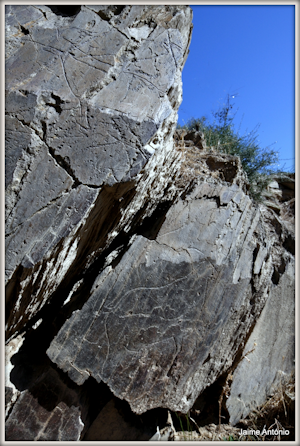
In 2011 the management responsibilities were transferred by the Portuguese government to the newly created Côa Park Foundation, charged with the duty of managing, protecting and researching the rock art as well as running the Museum and visits to the prehistoric art sites within the Park (Real 2014). Due to conservation and preservation issues, strict rules were initially set for visits to the three rock art sites open to the public. A daily limit of visits was enforced and the policy was (and continues to be) to only allow guided visits (Fernandes 2004). To this day, the sites are also under surveillance by a specialised security firm, with the exception from 2013 onwards of the Ribeira de Piscos rock art site due to budget cuts. At the end of 2017, a security guard was again put in place at Ribeira de Piscos – similar to what continued to occur at the other two sites – in the wake of the revitalisation process of the Côa Park Foundation, set in motion by the newly appointed Directive Board (Andrade 2017; Sapo24 2017).
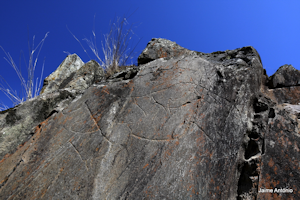
Almansa Sánchez (2013) recommends caution when using an online presence to involve the public and communicate archaeology, as it may end up reinforcing erroneous popular stereotypes and implementing inaccurate editorial guidelines with the aim of reaching the 'masses'. Nevertheless, at the same time, he suggests that this is one of the paths to follow if archaeologists wish, on one hand, to have an influential and respected voice in society and, on the other, to strengthen the archaeological community which can be somewhat fragmented and, at times, feebly involved. Although an online presence, particularly on social networks, does not replace direct contact with the public, it should be an additional tool in the creation of public archaeology programmes. In creating these strategies, it is essential to pursue an editorial line that clearly defines what, how and with whom to communicate. Therefore, the website of an institution such as the Côa Museum and Archaeological Park should be regarded as the primary repository of information, organised in a searchable manner, from which social media presence is fed. Despite this, it has been the Facebook page that has become the favoured platform for the Côa Museum and Archaeological Park's tourism, cultural and pedagogical programme. Indeed, Facebook is the most popular social media platform in Portugal and also among Museum employees. Moreover, the viral reach of posts is quite interesting considering that Facebook is often the preferred platform to convey important institutional messages, despite the relatively small number of the Museum's Facebook followers (see below). Take for example, a recent vandalism incident that occurred at one of the Park's engraved Upper Palaeolithic rock art surfaces (Ribeira de Piscos Rock 2). Contrary to what had happened in 2001 when a similar event was not publicised (Fernandes 2010b), this time it was decided to denounce the action on Facebook, not only to demand a swift police investigation but also to make a pedagogical example out of the incident. That particular post swiftly went viral, reaching almost 80,000 users and receiving over 3,000 total reactions. If indeed bad news travels fast(er), it is significant that the post reached six times more Facebook users than the number of Côa Museum followers. So, when wanting to make a certain piece of information widely known, this is one of those situations in which building a social media audience, namely in Facebook, eventually pays off.
The creation of the Museum's Facebook page has been quite an organic process. In October 2011, the IT coordinator at the Museum, who already had an account on Facebook, decided to create a page for the Museum because "it needed one, since everyone was joining Facebook and an institution such as the Museum also needed to be present" (Patrícia Lucas, pers. comm.). The rising number of followers clearly indicated that the task of managing the Museum's page should be carried out by a single staff member. I was asked to undertake this role due to being part of the Museum's Education Service, and having both experience in using Facebook and a personal interest in the use of social media by cultural institutions.
One of the major challenges in the online presence of any given cultural institution is to capture the attention of an audience constantly bombarded by large amounts of information while, at the same time, effectively sharing meaningful, pedagogic and promotional content that can also boost visits to the 'real thing'. At the Côa Museum, I regarded an online presence as something of 'monster' that needed to be fed often. This metaphor should not be taken in (too) negative a light but rather as a realisation that drawing in and maintaining online audiences takes effort, consistency, and persistence. It was decided not to use the page only to publicise our regular museum activities and events as that would not give that many posting opportunities. In academia, the dictum 'publish or perish' (for instance, De Rond and Miller 2005) will make sense: but 'publish or be invisible' is its equivalent for social media. Various authors have discussed this issue and the outreach constraints caused by platforms' proprietary algorithms regarding visibility (Bucher 2012), or the existence of 'non-participatory' invisible audiences (Rothbard 2014). Others take a more positive outlook and believe institutions can take advantage of social media to amplify visibility to help reach their goals (Ang 2011) and even to improve internal communication (Leonardi 2014). If there is a social media presence, coordinated efforts must be pursued to reach a wide audience and expand the number of followers. By definition, that is the essence of social media although many show concern regarding the dangers of a loss of authenticity when trying to reach larger, more heterogeneous, audiences (Gensler et al. 2013; Hanna, Rohm and Crittenden 2011; Samuel 2017). While some argue that technological authenticity is achievable (Wang and Skovira 2017), perhaps the notion that "Real conversations and relationships are a two-way street" (Reynolds 2016) is helpful, provided that these lanes are seen as potentially connecting countless interwoven paths at (both virtual and physical) intersections where "Moments of wonder, laughing, surprise, discovery, pleasure and 'complicity'" (Vlachou 2013, 128) can occur. This is one of the reasons why visitor-produced content after a visit to the Côa Museum (photos, reviews or even drawings) are frequently published/republished on Facebook and/or Twitter. It is a way of attempting to value individual input but also of adding other voices to the ongoing and multifaceted dialogue established between the institution and its audiences.
Social media pages should actively engage in liaising with other pages/sites that share common interests that can enhance the proposed visibility and dissemination objectives. Such an approach does not need to be to resource-intensive; indeed, it is foremost a matter of creating and curating an informal and (inter-)platform network of closely-located and/or -themed pages by consistently liking, sharing and commenting on each other's relevant contents, while respecting the core essence and goals of each. Therefore, the Côa Park and Museum social media pages regularly share content and its content is shared by several pages/sites within a network that ranges from the municipalities where the area of the Park is located to UNESCO's World Heritage Commission. What matters most is not exclusive content but the reach of posts and thus overall public engagement success. The online presence aims to promote and divulge the Côa Valley rock art heritage so that its educational, touristic and economic potential is boosted to benefit a less affluent area of Portugal (Decreto-Lei 35/2011; Decreto-Lei 70/2017; see also Baptista 2014; Real 2014).
Framing subsequent discussion, a succinct analysis of the Côa Museum and Archaeological Park web domain and social media presence will be carried out. The principal aim of this exercise is to evaluate the institutional communication strategies that have been implemented, but also to understand if visitor expectations before and after a day at the Museum and/or Park are being met by its online presence (Marty 2007). It is worth stating that I have the main responsibility for managing social media presence (Facebook, Twitter, YouTube, and TripAdvisor) due to my affiliation with the Museum's Education Service and the significant goals these platforms are thought to pursue in public archaeology policies. Nevertheless, different staff ranging from administrative personnel to photographers and archaeologists are involved to a greater or lesser extent in managing and producing content. The former director of the Côa Museum and Park, António Martinho Baptista, often published messages and photos on the Facebook page; other photographers and designers whose work is published on Facebook, Twitter and TripAdvisor include Jorge Davide Sampaio, Jaime António, Mário Reis, José Paulo Ruas, Pedro Guimarães and João Romba. From September 2017, the current president of the Foundation's Directive Board, Bruno J. Navarro, has taken part in the Facebook page's management. YouTube is co-managed by myself and by fellow staff archaeologist Mário Reis, who has also been responsible for updating the website, under the supervision of IT services at the Direção-Geral do Património Cultural in Lisbon (DGPC), where the server is hosted. Since the beginning of 2018, I have taken charge of the website.
The creation of the domain arte-coa.pt was coordinated by IGESPAR (the former Portuguese government heritage management body replaced by DGPC) and CECL (Centre for the Study of Communication and Language at Nova University, Lisbon), produced by UAUM (Minho University Archaeology Unit), designed by CECL and programmed and developed by CCG/ZGDV. The website went live when the Côa Museum opened in 2010. The encyclopaedic nature of the website is reflected in its varied content on matters related to the Côa rock art, namely: Art, Image, Culture, Language, Environment and Territory, Man and Territory, Art Beyond Côa, Art Contexts, Tourism or Archaeology and Human Occupation. It also contains sections with data on the Park rock art sites, as well as useful visitor information. There are hundreds of rock art photos and drawings, photos of the region, a glossary, a repository containing over one thousand freely-downloadable scientific papers and other historic documents including the various posters produced over the years to promote the Côa rock art and the activities of the Park and Museum. The domain is bilingual, available in Portuguese and English.
Google Analytics has been a very useful tool to assess the reach of a given web page or web domain, and was implemented on 23 June 2014. All the visitor statistics below relates to the period between this date and 27 April 2015 except where otherwise noted. Figure 5 reveals total data regarding the target audience and reach of the site, namely: a) number of sessions: 63,924; b) number of users: 52,228; c) number of page views: 182,065; d) number of pages per session: 2.85; e) average duration of each session: 00:02:21; f) bounce rate: 63.33% and g) rate of new sessions: 81.70%. According to Schwartz (2014), Google has changed its terminology regarding 'unique views', which are now termed as 'users', and 'visits', which are now 'sessions'. Hence, unique views during this period totalled 52,228. While a), b), e) and g) do not require further explanation, other items require more detailed attention. Number of page views corresponds to the total of page views for the entire arte-coa.pt domain. Total views is important because this is the main metric used to evaluate the reach of a web page or domain. Bounce rate corresponds to the percentage of visitors who access only a single page (usually referred to as the landing page) before leaving the domain. Generally speaking, this item corresponds to the visitors who, after conducting a search, realise the page on which they land is not of interest or what they wanted to access.
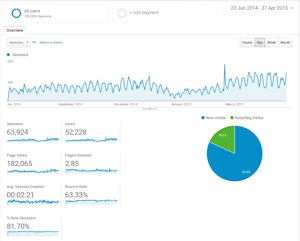
Data provided by Google Analytics are delivered without further comparison terms and thus need to be cross-checked towards a more wide-ranging evaluation of online presence. Accessing data on page views (and consequently the ranking of web pages and domains that may serve as a cross-reference) is difficult because there are many data providers in the market but access is expensive. However, partial data available from free-of-charge test versions of these commercial applications can be used. In the case of Portugal, partial data are available from a market survey firm that provides free access to the ten most visited pages and domains, according to its metering panel. For example, the tenth most visited domain (xl.pt) in the MARKTEST sorting had 48,657 page views in March 2015 (MARKTEST 2015). The arte.coa.pt domain had 25,840 page views in the same period of time (see Figure 6).
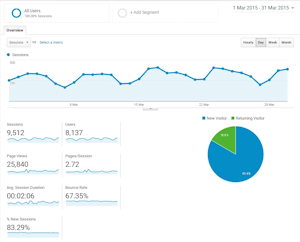
Other data will contribute to better characterise the reach of the arte-coa.pt domain, especially those regarding visitor country of origin, age, and gender. Brazil is the country with the most visitors (40.73%), closely followed by Portugal (38.08%). The expected presence, albeit with more residual values, of other countries such as Spain and France in the top ten and, perhaps less expected, of USA and Angola should also be noted. The fact that Brazil, the largest Portuguese-speaking country, is in first place might help explain why the bounce rate is higher than average in that country, as illustrated in Figure 7. It also confirms that most traffic from France probably comes from the substantial Portuguese immigrant community there, as this country has the lowest rejection rate of the top ten. The argument here is that a considerable number of Brazilian visitors mistakenly visited arte-coa.pt while browsing for other content since the likelihood of already knowing about the Côa Valley is reduced. Conversely, it is considered that most visitors from France did land exactly where they wanted. Data for the bounce rate (63.33%), higher than what is usually suggested for this metric (where >55% and <85% is considered to be higher than average and somewhere between 30%-45% considered excellent (Peyton, 2014)), should be understood in the light of the visitor origin analysis above. Sometimes bounce rate is classified according to page type: for a content website such as the arte-coa.pt domain, the referred to average bounce rate interval is 40%-60% (Kusinitz 2017). Using this categorisation, the bounce rate can perhaps be regarded less negatively. Data concerning age and gender of visitors are presented in Figure 8 (see below for a comparative analysis regarding data from the Côa Museum YouTube channel).
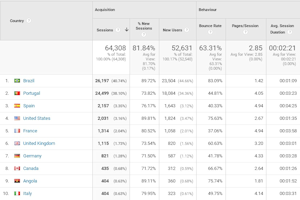

Other metrics are helpful to optimise the reach of a web domain, in particular those relating to device use and most viewed pages. Figure 9 confirms that the majority of traffic (almost 80%) reaching the site does not originate from mobile or tablet devices. Therefore, investing in optimisation to better meet display and navigation needs of these devices may not be considered urgent if increasing the share of traffic originating from these increasingly popular appliances is not seen as a priority. However, it should be noted that Google, arguably the world's most popular search engine, has recently changed its search algorithm in order to favour web pages best suited for mobile devices (Público 2015). Figure 10 shows the most visited pages in the arte-coa.pt domain. Not surprisingly, the homepage is the most visited, followed by the page containing visiting information on rock art sites within the Côa Archaeological Park. This data allows the determination of which domain pages may need improvements, and also confirm that the Museum online presence also provides a public service. It also enhances understanding of what kind of content audiences tend to look for when visiting the website.
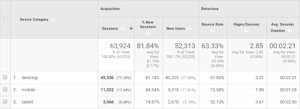
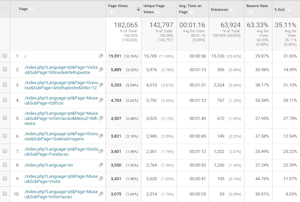
Page access data analysis (i.e. how visitors reach the page) also provided relevant information. Most visitors reach the domain through an organic search (Figure 11), with Google being the most popular search engine (Figure 12). The figures for direct reach (visitors who access the page by typing the address in the browser's address bar), via another page or social media, are much lower. The domain that sends the most online traffic to arte-coa.pt is the web page of the town council of Vila Nova de Foz Côa (Figure 13). Figure 14 shows that Facebook by far leads the list of social media platforms sending the most online traffic. However low this figure is, it is useful to determine that posts on Facebook have obtained good results in attracting visitors to the domain. As an example, a peak occurred on 12 July 2014 (Figure 14) when the educational activities on offer by the Côa Valley Museum and Archaeological Park for that summer were published/linked from the website on Facebook.

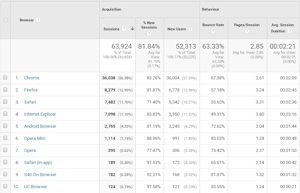
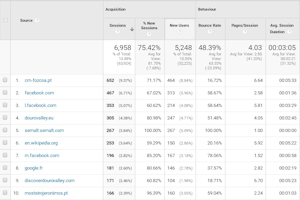
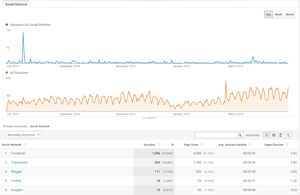
The main concern when establishing the Facebook presence was to follow editorial criteria anchored around three main promotion and dissemination objectives: a) the aesthetic and scientific relevance of the Côa Valley rock art in particular and world rock art in general; b) the regular and seasonal activities aimed at different segments of the general public, namely, but not only, those carried out by the Education Service; and c) detailing the rich regional cultural and natural heritage features. Right from the beginning, Facebook posts of high-quality images of the rock art, the Museum building, and the scenic regional landscapes were favoured. These are the most popular posts amongst followers of the page, attaining a high number of Likes, Comments, and Shares (Figure 15). Once the attention of the Facebook audience is captured by these evocative images, their associated captions try to present relevant information, in an exciting and educational manner, on the rock art and its overall context, on activities carried out by the Museum organised by the Education Service, or how to visit the three sites that are open to the public. Captions often include a "find out more" link pointing to more lengthy news and reports or to the bibliographical archive area of the website. An example of such content is the bilingual (Portuguese/English) Newsletter 'The Côa in Numbers' which presents interesting and/or curious details of the Côa Valley rock art (Figure 16). In short, editorial guidelines can be summed up in a simple idea: to promote, disseminate and transmit knowledge while also trying to entertain.
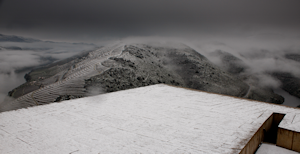
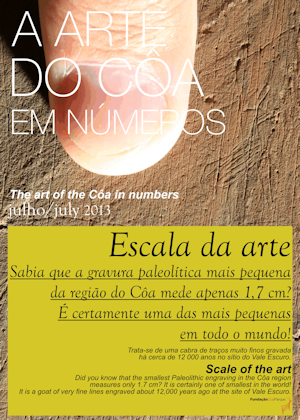
By September 2017, the Facebook page has attained over than 13,000 Likes. A search using the word "Museu" in the Portuguese Facebook ranking rankUPt site positioned the Côa Museum in the eleventh position, according to the number of Likes. In the "Art, Culture and Leisure" category, rankUPt lists the Côa Museum Facebook page in 262nd place out of a total of 899 pages. Figure 17 displays the age, gender and geographic location of followers as supplied by Facebook and shows the majority of followers to be female. These data align with the domain analysis above. As for Facebook reviews, the page has a 4.8 out of 5 average from a total of over 120 reviews. The vast majority of positive reviews praise the overall visiting experience to the Museum and to the rock art sites.
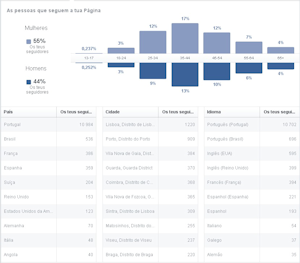
The creation of a YouTube channel was aimed at developing an accessible repository of the region's recent history, especially of the Côa Museum and Archaeological Park, taking advantage of the large video documentary collection the institution holds. More than 50 videos have already been uploaded and made available to the public include documentaries, short animation and promotional films, news broadcasts and TV debates. Each, in its own way, is an historically important document, in particular with regard to the controversy that took place in the mid-1990s about in situ preservation of the Côa Valley rock art (Baptista and Fernandes 2007). Another objective of the channel was to complement the online presence as videos uploaded to YouTube are periodically shared on Facebook and Twitter, and are often among the most popular content.
A further purpose of the YouTube channel was to archive and share the videos produced by the Côa Valley Museum and Archaeological Park such as "O Que Aprendi - Fernando Barbosa e a Arte do Côa" ("What I Have Learned – Fernando Barbosa and the Côa Art") or "Uma Visita ao Parque Arqueológico do Vale do Côa" ("A visit to the Côa Valley Archaeological Park"). These short videos, directed and edited by me in partnership with Jaime António, were produced using widely available, semi-professional video editing software.

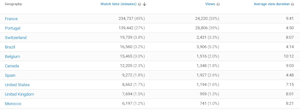
An analysis of the YouTube statistics for the Côa Valley Museum and Archaeological Park channel reveals that, since it began on 21 February 2013 until 21 May 2017, it had a total of 74,553 views and 519,663 minutes watched (see Figure 18). Subscribers to the channel surpass 200. The analysis of views per country from which the majority of the traffic originated is somewhat surprising since France (33%) almost matches Portugal (39%) (Figure 19). However, statistics concerning the most watched videos (Figure 20) explains this as at the top of the list is positioned, by far, a French documentary. This is in line with the above mentioned regarding the low bounce rate of visitors originating from France. If data on age of visitors to the YouTube channel is fairly similar to the stats for arte-coa.pt and the Facebook page (although the YouTube audience is slightly older; see Figure 21), gender data are quite different. This shows a very high percentage (approximately 70%) of male visitors. Even though the period of time is different, the percentage of male visitors to the domain was c. 54% while for Facebook it was only 44%. The YouTube average percentage viewed stats (see Figure 22) suggests that shorter videos can retain, on average, an audience's attention for longer and, therefore, are more effective in engaging audiences. Even when considering that these pieces have short running times (around 3 minutes each), the analysis in Figure 22 shows that promotional videos produced by the Côa Valley Museum and Archaeological Park attain higher average viewing percentages (red arrows). This finding is corroborated by the viral reach (within the scale of the Museum's Facebook presence) achieved by the video "Uma Visita ao Parque Arqueológico do Vale do Côa / A visit to the Côa Valley Archaeological Park" when recently published directly on the Facebook page. In fact, it has since become the Museum's second most popular Facebook post.
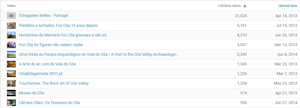
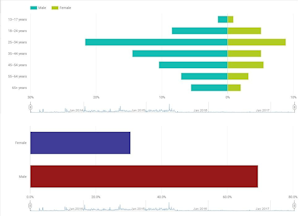

Our Twitter page has been active since January 2014. Recalling a well-known saying, I decided to complement our presence in social media by creating a Twitter page so as not to 'put all our eggs in one basket'. Expansion to other social media platforms promotes both the creation of original content and adaptability in handling online presence by institutions and professionals responsible for it. This platform was chosen due to the higher usage by younger segments of the population, in addition to its interesting pedagogical and education support role (Junco, Heiberger and Loken 2011; Soltero 2012; Sloan et al. 2015). It is not meant to be a mere duplication of the Facebook page, although there is some content which is shared on both platforms. However, because Twitter is directed at an international audience, this platform content is more often published in English and there is content that is exclusive to Twitter. This is the case with our participation in Twitter's #MuseumWeek. This initiative, occurring during a whole week, aims to maximise museums' visibility and promotion in social media, and consequently, in current societies (MuseumWeek 2015). Obviously, content is multi-shareable and, in the case of #MuseumWeek, the Facebook page also echoed this initiative even though it was designed to be primarily carried out on Twitter. Our participation was summarised using Storify, an application that creates 'stories' from shared content on various social media platforms (Storify 2014), which was used in 2014 and 2015.
As at September 2017, the Twitter page had attained just over 13,000 Followers, a figure similar to that of the Facebook page. Figure 23 details data regarding origin, language, age, and gender of Twitter followers. The most striking information is the fact that the majority of followers register as English-speaking, marginally surpassing Portuguese-speaking ones. Even if data regarding the origin of traffic sheds a different light on the matter, the fact that the country where the Côa Valley is located only accounts for 51%, suggests a quite reasonable international outreach of the Twitter page. Figures regarding age and gender of followers are in line with those recorded for the website and Facebook page but not, as noted above, for the YouTube Channel.

Côa Museum and Côa Valley Archaeological Park
TripAdvisor claims to be the largest holiday recommendation site in the world with over 340 million monthly users, 350 million user opinions and comments covering more than 6.5 million accommodations, restaurants and attractions located in 48 different countries (TripAdvisor 2016). TripAdvisor reviews constitute a sort of visitor book (see Aljahdali 2016) and play a significant role in online travel search and therefore in planning holidays (Xiang and Gretzel 2010). TripAdvisor also constitutes a valuable internal tool to ascertain visitor satisfaction levels since it is independently run and reviewers have no connection with rated attractions. Due to the publicity and reach a site with such characteristics entails, rated institutions need to take reviews seriously, particularly the less positive ones. In the case of the Côa Park and Museum, despite the number of less favourable reviews being quite low, these have already motivated minor adjustments to the current visitor scheme. Moreover, I reply to user comments, namely the few (see below) that have a negative opinion on the visiting experience, and regularly submit photographs and updates to the information available on the pages regarding the Museum and Archaeological Park.
Originally, only a page for the Museum existed in TripAdvisor, aggregating reviews regarding both the visit to the Museum and the Archaeological Park. In 2015, TripAdvisor decided to create a separate page for the Park; hence, the quite higher number of reviews for the Museum. The Museum and Archaeological Park pages have an average classification of 4.5 in a rating system that goes from 1 (Terrible) to 5 (Excellent). As at September 2017, the Museum had 302 reviews with the Park at 75. For a successive four years (2013-2016), the Museum has gained the TripAdvisor's Certificate of Excellence. Due to the constancy of positive reviews, the Museum has also been nominated in the 2016 Traveller's Choice Attractions Award. It is to be expected, as reviews grow, that the Archaeological Park may also attain these recognitions in the near future.
Today the Côa Museum continues to lead a sustainable and comprehensive development project for the region (Fernandes et al. 2008; Fernandes 2013). Promotion means to defend cultural heritage, managing the territory is to conserve the rock art, selling merchandise is to promote, offering meaningful educational experiences is (also) to entertain and using social media is an endeavour to engage broader audiences. All these actions are undeniably interlinked and modern museums have to harness the full potential of creating synergies amongst the different goals, especially as today's budgetary constraints dictate the need to attract new sources of revenue. Ideally, all museums should be safe from financial restrictions. In reality, and the Côa Museum is no exception, the contemporary trend in Western countries is to maximise gains and downsize expenses. Even if it is believed that there are limits to both, which ultimately might endanger the endurance of any given institution, to consider the above-mentioned goals holistically will provide a chance to adapt aims and strategies internally. Social media offers yet another avenue where these goals might be promoted. The previous section points to the importance of creating a diverse online audience, thus enhancing the promotional, heritage preservation awareness and community outreach efforts central to the Museum and Archaeological Park's legal duties since 1996 (Baptista and Fernandes 2007; Fernandes 2004, 2007). In this light, the denouncement of the act of vandalism on one of the Côa Valley outcrops on social media that swiftly became viral should be integrated into this kind of approach, and try to avoid future incidents.
If the objectives behind the online presence of an institution such as the Côa Valley Museum and Park have mainly to do with the promotion of a cultural tourism product, the dissemination of research carried out in the last 20 years on the aesthetically outstanding rock art of the region (Baptista 2009) is also important. The section of the website containing the vast bibliographical archive of papers on the Côa Valley rock art should be also regarded as a component of the Museum's open access policy. In the last few years, museums have embraced the promotional possibilities offered by social media (American Alliance of Museums 2017; Espinós 2016; Hannon 2016; Stein 2017). The presence on these platforms can be regarded as another way of pursuing a socially-oriented public service; many make a point by including this in their mission statements (Russo et al. 2008; Serota 2014). I believe it is straightforward to state that having open access content available, not infringing on third parties' copyright, without any or few restraints (besides the existence of an internet connection, see below), contributes to building more inclusive, sympathetic and socially resilient communities (but see Kaplan and Haenlein 2010; Kidd 2011; Russo, Watkins and Groundwater-Smith 2009).
Some express the fear that making content freely available online will make potential visitors feel that there is no need to physically visit the museum. The former President of the Côa Park Foundation, Fernando Real, expressed such a concern when the Facebook page was created (pers. comm.). Others explicitly state that "Facebook does not sell tickets…" (Vlachou 2013, 126). Nonetheless, there are opposing views, namely that an active online and social media presence contributes to increasing visitor numbers and engagement at Museums and similar institutions (Doosti et al. 2016; Davies 2014; George 2012; Maurer 2011, Padilla-Meléndez and Águila-Obra 2013). It is reasonable to assume that a segment of the public will always want to visit the 'real thing' even with the opportunity of browsing online content beforehand (and also because of that). It is problematic to know precisely how large this segment is, as specific national contexts affect the detailed analysis and also determine its magnitude. Considering overall visitors to museums, if data from the USA points to just a quarter of Americans visiting museums, in the UK more than 50% of Britons visit museums each year (Farrell and Medvedeva 2010; Gov.uk 2017). In Portugal, available data points to low visitor numbers to museums by nationals when the total population of the country is considered, although there have been steady increases in the last few years (TSF 2017). Be that as it may, the inclination to visit real museums instead of virtual ones may be based on the notion of authenticity; the 'aura' and 'patina' of the 'real thing' being much more alluring than a digital screen, the radically different experiences in observing real or virtual work of arts or archaeological pieces, or the impossibility of viewing the two experiences as even remotely similar (McDonald 2005; Orviz 2014; Smith 2011).
It is believed that an online promotion strategy should serve a double purpose: a) to deepen access by the public to cultural heritage and b) to invest in the creation of future audiences (Arora 2012; Connolly and Bollwerk 2017; Fletcher and Lee 2012; Thomson, Purcell and Rainie 2013). A related discussion is one of determining if the universal availability of online content should remain free of charge or if interested audiences should pay for access (European Commission 2016; Maron, Smith and Loy 2009; Taylor and Gibson 2017). Regarding small and medium-sized institutions, such as the Côa Museum, where budget constraints are more of a consideration, the answer to this question may be selectivity; while some contents can be made available free of charge, access to others could require some sort of payment. It is suggested that for small to medium museums, the ratio of free vs pay-to-view material could be around 1 to 3 or even 1 to 4. This would mean that free-of-charge materials could be selected from those that do not have associated copyright issues. On the other hand, paid-for content could help sustain the costs of digitisation (Maron, Smith and Loy 2009). Criteria for selection will be closely connected with the specific context of each museum, although some commonalities include desirability, rarity or relevance of contents. Considering the specific case of the Côa Park and Museum, this issue is perhaps less pertinent since visitors are permitted to photograph the Museum contents as well as during the visits to the rock art sites. Nevertheless, since it is complicated to achieve good results without the right photographic experience and material, requests to use the rock art documentation material produced by the Park and Côa Museum in the form of photos and drawings are considered on request and, normally, only those for non-commercial or institutional tourism marketing use are accepted free of charge.
As stated earlier, the web and social media platforms today constitute a tendentially democratic communication tool to reach vast audiences. The expression "tendentially democratic" is used since the number of individuals using the Internet has been growing exponentially over the last few years, as the 936% overall increase rate in Internet users for the period 2000-2017 indicates (Internet World Stats 2017). However, the name "World Wide Web" remains inaccurate, as there are large portions of the population who still do not or cannot access the internet. For instance, in Portugal, the huge majority of non-internet users are the elderly and those who did not complete primary education (OBERCOM 2012). These profiles, closely related to low income, help to characterise the digital divide in access and use of IT suggested by Dijck (2005). It is a well-known and discussed fact that the majority of visitors to museums and heritage sites belong to the more affluent and educated segments of contemporary societies (Adams 2016; Lampi and Orth 2009; Kotler and Kotler 2000; Walhimer 2017). Such a state of affairs has traditionally been equated with the difficulty of rendering museums more broadly open to all audiences (Richards 1996). Nevertheless, it is believed that while a web and social media presence is not the sole answer in attempting to bridge the socio-economic gap in museum and heritage sites' audiences, it provides communication channels that can be strategically used to further such an endeavour. In that regard, despite the relatively low percentage of senior users of the Park and Museum's website and social media platforms, the data presented nevertheless suggests that the implemented online presence does reach diversified audiences. Since devices are more affordable and user-friendly, the investment to upgrade the Park and Museum website to comply with the adequate browsing requirements might promote an even wider use of the arte-coa.pt domain. The development and implementation of specific apps, to provide information for planning a trip to visit the rock art sites or to allow immediate online booking, might also be worth consideration.
One should not be so naive as to think that social media is completely free of restrictions or that it is not fully part of global market dynamics (Cohen 2008; Fuchs 2013, 2017; Mangalindan 2011; Varney 2014). On the contrary, it has carved its particular niche in today's capitalist societies, amassing a huge amount of personal data from its users and exploiting it to economic advantage, such as trying to get page owners/managers to pay for outreach (BizTraffic 2016; Fisher 2016, 89; Sashittala et al. 2012; Veldt 2013). Moreover, social media can be (and is) used to further uphold social control (Fisher 2016; Kung 2013; Prodnik 2016; Trottier 2016). This happens not only when powerful statistical analysis tools are employed but also, such as in the case of Facebook, by making it an echo-chamber of newsfeeds with the majority of content 'selected' for us reinforcing our own points of view. This is what is known as the "Filter Bubble", a term created by Pariser (2012) to "describe the potential for online personalisation to effectively isolate people from a diversity of viewpoints or content" (Nguyen et al. 2014, 677). Although most people prefer an (illusory) sense of belonging and avoid confronting opinions, it is up to users to educate themselves and the institutional pages they manage through diversifying their newsfeed. This may be achieved through liking, sharing and commenting on contents with contrasting views, in order to bypass the isolation typically generated by the newsfeed algorithms (Bisgin, Agarwal and Xu 2010; Tarbush and Teytelboym 2012).
One of the ways to keep this in check (or even to counter it) is to have multiple sources creating information across various locations. While reach of social media posts is determined to a degree by the opaque and evolving algorithms that govern each platform and ultimately give precedence to certain types of posts, control over content is still exerted by page managers or owners. The greater number of information sources there are, the more sources need to be filtered. So, if this filtering is conducted according to specific interests, social belonging and even prejudices, more importantly, it is controlled by powerful algorithms that take into account localisation, user preferences, previous actions or demographics (Dijck 2013, 154-176; Mager 2012). Users have little or no control over these algorithms, and are subject to the changes made according to the goals of platforms (Wallaroo Media 2017; Whitney 2016) — although it is apparently possible from a marketing point of view to counter them (Jackson 2017). However, there is some hope that we are moving towards more ethical and transparent social media environments (Beer 2009; Bertot et al. 2010; Fuchs 2017, 341-356; Gil de Zúñiga, Jung and Valenzuela 2012; Linders 2014; Lyon and Montgomery 2013; Noller 2013; Shirky 2011) — environments where audiences face contrasting viewpoints; that foster engagement in questioning and mediate dialogue between individuals but also between different institutions such as museums. Moreover, as the viral spread of the Facebook post on the vandalism incident discussed above suggests, it is still possible, within an algorithm-controlled environment, to reach significantly larger audiences.
As suggested by Fuchs (2017, 85-118), Sivek (2010) or Revis (2011), the current state of affairs is changing from a situation in which the public filters through already-sieved information, itself made available by the relatively few yet diverse traditional media platforms (newspapers, radio, television or cable news) that often report in a controlled or even biased fashion (Breed 1955; Goode 2009). The emergence of multiple sources of information resulting from the rise of social media platforms enriches this process while having the potential to strengthen social cohesion and the proactive role of citizens in our tendentially democratic societies (Gil de Zúñiga, Jung and Valenzuela 2012; Loader and Mercea 2011). Even if the downside is to admit the power of fake news to tamper with democratic processes (Fidler 2017; Gray 2017), the disapproval and resistance that these attempts have been met with demonstrates the resilience of free will and thought, and ultimately provide some degree of hope on the potential uplifting role of social media in contemporary societies.
As counter-intuitive as it might seem, the risks of cross-posting on different platforms or of oversaturation for users are overshadowed by the visibility and promotion advantages, especially within an environment where a myriad of similar institutions are competing for attention. In fact, the buzz around a particular site created just by posting unadvertised contents (the Museum has never paid for outreach in its different online platforms) might be beneficial, especially in the case of a museum located in a less densely populated area of a country on the periphery of Europe such as the Côa Park and Museum.
Perhaps the role social media can play in the promotion of cultural institutions and help to counter late capitalism dynamics in this context, has been portrayed here in an optimistic fashion. Not all (or many) cultural institutions will be able to endure while resisting, even feebly, the growing marketisation of culture (Coombe and Weiss 2015; DesRoches 2015; Lee and Carruthers 2015; Leniaterk 2015; Rodney, 2015; Toepler and Dewees 2005; Vlachou 2013, 49-62). Financial constraints may weaken the role cultural institutions can play, not only as keepers of different sources of (personal or communitarian) knowledge and memories, but as creators of social equality and as the place where different traditions and cultures can meet (Silberman 2012). Due to the potentially challenging and questioning nature of most, if not all the collections they keep and can (digitally) share, museums are in a privileged position to make a stand against a process in which social media also plays a leading role: the 'stupidification' (Greenfeld 2014) and promotion of ignorance sought by active players forcefully present in these platforms while trying to hide behind (apparently) free market dynamics. It is a matter of trying to change a client-based mentality in the broader cultural sector as elsewhere; to attempt to engage, question and confront audiences in such a way that complex and more demanding issues become easier to grasp and, more importantly, to plant the seed of curiosity, where independent thought processes are fostered and empathy towards diversity is stimulated. This process should be accompanied by a shift in the way museums and similar institutions engage with audiences - through creating multi-dimensional communication channels with those individuals or collectives willing to participate and making their voice heard in the iterative and on-going democratic process of memory creation (Russo et al 2008). In a world where usage grows steadily (Perrin 2015), museums should be very aware that individuals, NGOs, non-profit and for-profit organisations all have a significant role in making social media pivotal, and should consider its potential as a wide-reaching communication tool when establishing and consolidating networks of interested parties that feel rewarded by participation (Droitcour 2017; Madison 2017).
This article argues for the role that an online presence, including social media, can play for cultural institutions such as museums by a) countering the totally free market dynamics that narrow or even pulverise the range of currently available content, and b) by shaping social cohesion when enhancing tolerance towards diversity. In the case of Côa Park and Museum's social media strategy, editorial criteria echo the institution's decision to favour heritage values over the construction of a major dam (Baptista and Fernandes 2007). Additional communication strategies have attempted to expand visibility while continuing to contribute to the preservation of these values. Even if the link between an active and consistent online presence with an increase in 'real' visitor numbers is difficult to quantify, its reach has been part of the consolidation of the Côa Park and Museum's sustainable development project. A case in point has been the vandalism incident. Its going viral ensured that the Portuguese public became very aware of the repercussions and a parliament commission was set up to discuss the matter and propose recommendations that could prevent such unfortunate occurrences in the future (Nadais 2017). Although these were already being prepared (Santos 2016), two months after the vandalism incident, the Portuguese government announced a series of measures which are currently being implemented to revitalise the Côa Park Foundation and managing institution of the Park and Museum (Andrade 2017; Diário de Notícias 2017; Sapo24 2017). The growing number of internet users and growth of social media platforms has meant an exponential increase in the production of information over the last few years. As guardians of human memories, museums have an important role to play in providing widespread access to their collections, facilitating scientific research and fostering its use for educational, leisure or recreation. It is believed that the creation and delivery of online content by museums, other similar institutions and by the people, will all contribute to making data available for more in-depth and varied future accounts of contemporary history.
Internet Archaeology is an open access journal based in the Department of Archaeology, University of York. Except where otherwise noted, content from this work may be used under the terms of the Creative Commons Attribution 3.0 (CC BY) Unported licence, which permits unrestricted use, distribution, and reproduction in any medium, provided that attribution to the author(s), the title of the work, the Internet Archaeology journal and the relevant URL/DOI are given.
Terms and Conditions | Legal Statements | Privacy Policy | Cookies Policy | Citing Internet Archaeology
Internet Archaeology content is preserved for the long term with the Archaeology Data Service. Help sustain and support open access publication by donating to our Open Access Archaeology Fund.